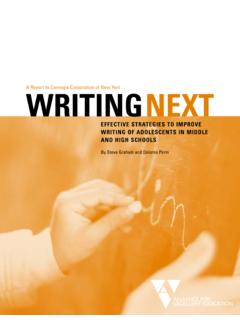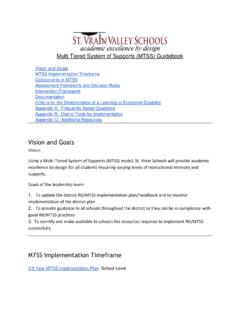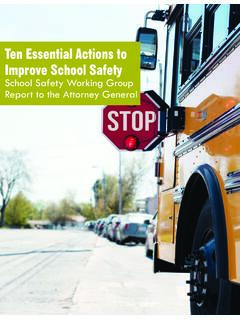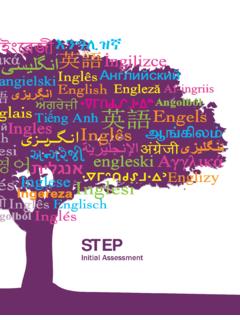Transcription of Targeted Support for Low-Performing Students
1 school Interventions That Work: Targeted Support for Low-Performing Students July 2017 school Interventions That Work: Targeted Support for Low-Performing Students | Improvement Under the Every Student Succeeds Act ..1 school Needs Assessments ..2 Elements of an effective school Needs Assessment Tool ..3 District Action: Link to Research-Based Practices ..4 Putting It All Together: The school Improvement Plan (SIP) ..6 Site Visits ..7 Conclusion ..8 Appendix ..9 Endnotes ..13 AcknowledgmentsThis report was prepared by the Johns Hopkins Institute for Education Policy (the Institute) for the Alliance for Excellent Education (the Alliance).
2 Cover photo by Allison Shelley/The Verbatim Agency for American Education: Images of Teachers and Students in Alliance acknowledges Carnegie Corporation of New York for its generous financial Support for the development of this paper. The findings and conclusions presented are those of the Alliance and the Institute and do not necessarily represent the views of Carnegie Corporation of New Alliance for Excellent Education is a Washington, DC based national policy, practice, and advocacy organization dedicated to ensuring that all Students , particularly those traditionally underserved, graduate from high school ready for success in college, work, and citizenship.
3 Johns Hopkins Institute for Education Policy (the Institute) believes that building partnerships across different constituencies is necessary to advance excellence and equity for all of America s children. The Institute operates on the understanding that education policy must be informed both by real-world conditions and also by excellent research; that it is possible to translate the technical vocabularies of research into a language that is accessible and useful to policy experts, principals, teachers, and parents; and that in our richly diverse nation, education must be driven and sustained by evidence about what works and what does not.
4 Alliance for Excellent Education, July 2017 .Table of ContentsSchool Interventions That Work: Targeted Support for Low-Performing Students | Improvement Under the Every Student Succeeds ActThe Every Student Succeeds Act of 2015 (ESSA) gives states and districts much more flexibility in determining how to turn around their lowest-achieving schools. ESSA stipulates that states must identify schools for improvement based on the performance of all Students and student subgroups. However, the Department of Education (ED) no longer may specify particular school intervention models, as it did under ESSA s predecessor, the No Child Left Behind Act (NCLB).
5 Moreover, funds previously set aside for school Improvement Grants (SIGs), a federal program that provided states with funds to Support persistently low-achieving schools, now flow through the regular Title I plan must be approved and monitored by the local education agency (LEA) . The improvement plan also must identify resource inequities for student subgroups performing at the same level as the lowest-performing 5 percent of schools . If the student subgroup fails to improve within a state-determined number of years, the state steps in with additional action .For state and district leaders faced with the challenges of Low-Performing schools, not much has changed.
6 It is not as if a new intervention strategy now has become available for district and state use . Once states identify the bottom-performing 5 percent of Title I schools, high schools with a graduation rate at or below 67 percent, and those schools with continually underperforming subgroups of Students , as stipulated in ESSA, leaders of schools, districts, and states must act . In the case of the bottom 5 percent of schools and high schools with low graduation rates, districts must lead comprehensive interventions . In the case of underperformance of student subgroups, schools must lead Targeted interventions . In both cases, the intervening agent must adopt one or more evidence-based strategies, where evidence is defined as a practice supported by the findings of one of three categories of research: randomized control trials (known as Tier 1 research), quasi-experimental (Tier 2 research), or correlational (Tier 3 research).
7 2 ESSA also outlines a broad process for intervening in schools with underperforming student subgroups that references Targeted Support and improvement plans, referred to throughout this report as school improvement plans :3 Schools, in partnership with stakeholders, must develop and implement an improvement plan for each underperforming student subgroup . This plan must be informed by all data indicators and include evidence-based interventions .4 Photo by Allison Shelley/The Verbatim Agency for American Education: Images of Teachers and Students in ActionSchool Interventions That Work: Targeted Support for Low-Performing Students | , ESSA envisions Targeted intervention to be the purview of schools and districts.
8 Under the law, states outline the parameters used to identify schools with consistently underperforming student subgroups and identify schools for intervention . But schools, in partnership with stakeholders, develop the improvement plans that districts must approve . Districts can apply to the state for funding to Support school -level intervention . There are several key elements of this process for identifying and intervening in schools that likely are required to raise the performance of under-achieving student subgroups . This report explores those steps, starting with a discussion of effective school needs assessments and school improvement plans (SIPs).
9 The appendix offers examples of evidence-based interventions for historically underserved Students . school Needs AssessmentsJust as a doctor s prescribed course of treatment fails if the patient s condition has been diagnosed incorrectly, a school intervention will fail if it addresses the wrong problem . The school needs assessment is the diagnosis, and the SIP sets out the treatment . ESSA requires that the thermometer used to identify a Low-Performing student subgroup includes indicators of student academic proficiency and growth or another academic indicator (for elementary and middle schools), high school graduation rates (for high schools), and English language proficiency, together with at least one state-selected indicator of school quality or student success.
10 For instance, data that shows poor performance in a student subgroup s math scores does not alone identify the cause for those low scores, which could range from poor instruction, poor curriculum, chronic absenteeism, poor morale in the school with attendant discipline issues, wrong professional development, lack of timely and disaggregated data, and more .ED s nonregulatory guidance makes the essential link between the needs assessment and the schoolwide improvement program explicit:Comprehensive improvement plans must be based on a school needs assessment, include evidence-based interventions, and identify resource inequities.








